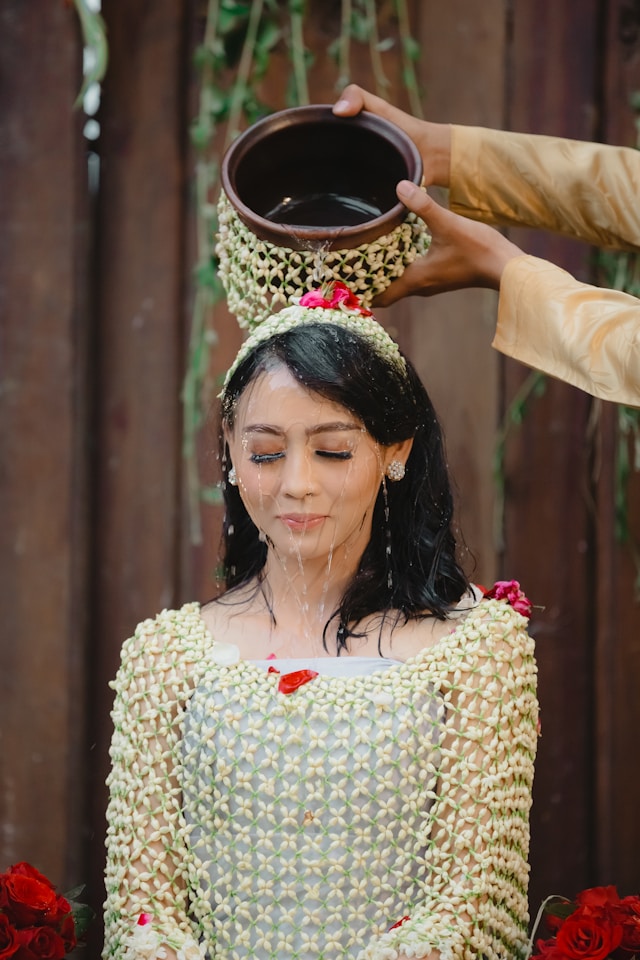Weddings are universal celebrations of love, commitment, and the joining of families. Yet, the way these joyous occasions are marked varies dramatically across cultures, reflecting the rich tapestry of human traditions and beliefs. In this article, we’ll embark on a global journey to explore some of the most intriguing and beautiful wedding traditions from various corners of the world. These customs not only add color and depth to wedding ceremonies but also carry deep symbolic meanings that have been passed down through generations.
Something Old, Something New: British Traditions
British weddings are steeped in tradition, with customs that date back centuries and continue to evolve. Perhaps the most well-known of these is the rhyme “Something old, something new, something borrowed, something blue, and a sixpence in her shoe.” This tradition, which emerged in Victorian times, is believed to bring good luck to the bride and her marriage.
Let’s break down each element:
Something Old: This represents continuity with the bride’s family and the past. It’s often an heirloom passed down through generations, such as a piece of jewelry or a fragment of lace from a mother’s or grandmother’s wedding dress.
Something New: Symbolizing optimism for the future, this is usually an item the bride will wear on her wedding day, like her dress or shoes.
Something Borrowed: This item, typically lent by a happily married friend or family member, represents borrowed happiness and the support of loved ones.
Something Blue: Blue has been associated with love, purity, and fidelity since ancient times. It can be incorporated in various ways, from a blue garter to a subtle blue thread sewn into the wedding gown.
A Sixpence in Her Shoe: This final touch, while less common today, symbolizes prosperity for the couple’s future together.
While not all modern British couples adhere strictly to this tradition, many find creative ways to incorporate these elements into their wedding day, blending old customs with contemporary style. London wedding photographers are adept at capturing these meaningful details, preserving the essence of British wedding traditions for generations to come.
Mehndi Magic: Indian Wedding Rituals
Indian weddings are renowned for their vibrant colors, intricate rituals, and joyous celebrations that often span several days. Among the many beautiful traditions associated with Indian weddings, the Mehndi ceremony stands out for its visual appeal and deep cultural significance.
The Mehndi ceremony typically takes place one or two days before the wedding. During this event, the bride and her female friends and family members gather for the application of henna, a natural dye, in intricate patterns on their hands and feet. The designs, which can take hours to complete, often include symbols of love, luck, and prosperity.

The significance of Mehndi goes beyond its aesthetic appeal:
Good Luck Charm: The intricate patterns are believed to bring good fortune and ward off evil spirits.
Symbol of Love: There’s a romantic belief that the darker the color of the henna stain, the deeper the love between the bride and groom. Some even say that the groom must find his name hidden within the bride’s Mehndi design on their wedding night.
Cooling Properties: Henna is said to have a cooling effect, which is believed to calm the bride’s nerves before the big day.
Bonding Time: The Mehndi ceremony provides a relaxed setting for the bride to spend quality time with her closest female relatives and friends before the wedding.
Artistic Expression: The designs themselves often tell a story, incorporating elements that are meaningful to the bride and her family.
The Mehndi ceremony is just one of many pre-wedding rituals in Indian culture. Others include the Haldi ceremony, where the bride and groom are covered in a paste of turmeric, believed to purify and bless the couple, and the Sangeet, a musical evening where both families come together to sing, dance, and celebrate the upcoming union.
Tossing the Bouquet: An American Custom
While many American wedding traditions have roots in European customs, some have evolved into uniquely American practices. One such tradition is the bouquet toss, a playful custom that has become a staple of wedding receptions across the United States.
After the ceremony and usually towards the end of the reception, the bride gathers all the single women onto the dance floor. With her back to the group, she then tosses her bouquet over her shoulder. According to tradition, whoever catches the bouquet will be the next to marry. The bouquet toss is often paired with the garter toss, where the groom removes the bride’s garter and throws it to the single men in attendance. Like the bouquet toss, it’s said that the man who catches the garter will be the next to marry.
While these traditions remain popular, many modern couples are choosing to adapt or forego them. Some opt for alternatives like presenting the bouquet to the couple who has been married the longest or simply preserving the bouquet as a keepsake.
For couples planning their wedding and looking for inspiration, platforms like Wezoree have become invaluable resources. Wezoree not only connects couples with vendors but also serves as a wellspring of ideas for wedding traditions, both old and new. Couples can explore how others have incorporated or reimagined customs like the bouquet toss, finding creative ways to make these traditions their own.
San San Kudo: Japanese Sake Ceremony

Japanese weddings are known for their elegant simplicity and deep symbolism. One of the most important rituals in a traditional Japanese wedding is the San San Kudo ceremony, which literally translates to “three three nine times.”
Here’s a breakdown of the symbolism behind San San Kudo:
The Three Cups: These represent the three couples being united through the marriage – the bride and groom, and their respective parents.
The Three Sips: Each set of three sips symbolizes different aspects:
First three sips: Heaven, Earth, and Mankind
Second three sips: Youth, Adulthood, and Old Age
Third three sips: The three human flaws – hatred, passion, and ignorance
The Number Nine: In Japanese culture, nine is considered a lucky number as it’s the highest single-digit number, symbolizing prosperity and longevity.
While many modern Japanese couples opt for Western-style weddings, the San San Kudo ceremony remains a popular element, often incorporated into contemporary celebrations as a way to honor tradition and family.
Conclusion
As we continue to evolve and adapt these traditions for modern times, the essence of weddings remains unchanged. They are, at their heart, a universal celebration of love and commitment, a time when communities come together to support and rejoice in the union of two people embarking on a shared journey through life.
Photo by Fahmi Ramadhan on Unsplash (Free for commercial use)
Image Published on June 18, 2021
Photo by Fas Khan on Unsplash (Free for commercial use)
Image Published on May 13, 2019
Photo by Stacie Ong on Unsplash (Free for commercial use)
Image Published on January 5, 2023







